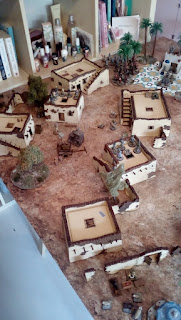Pour situer, la population ouighour musulmane est majoritaire dans le Sinkiang (du moins, à l'époque qui nous intéresse), mais la région appartient politiquement à la Chine. D'où son autre appellation de "Turkestan Chinois".
--------------------------------
I had a day off work today, which I used to unpack my Chinese Turkestan town for the Back of Beyond period, and take a few photos !
The Uighurs were the main ethnic group in this region in the early 20th century, but it belonged to China. Which explains the mix of architectural styles.
--------------------------------
 |
| Vu d'ensemble / Bird's eye view |
 |
| Le quartier chinois / The Chinese quarter |
 |
| Le vieux marché aujourd'hui délabré / A once splendid but now run-down market |
 |
| Le quartier musulman / The Muslim quarter |
 |
| Le tombeau d'un héros de l'Islam / A Muslim hero's tomb |
C'est d'ailleurs un peu impropre de parler de "quartier musulman" parce qu'une bonne partie de la population chinoise du Sinkiang, appelée les Huis, était musulman aussi.
Dividing the town into a "Chinese" and a "Muslim" sector is somewhat misleading, as a reasonably large part of the Chinese community of this region were Muslims. They were called Hui by their Han cousins.
Une table magnifique
RépondreSupprimertu as bien fait de prendre une journée de congés !